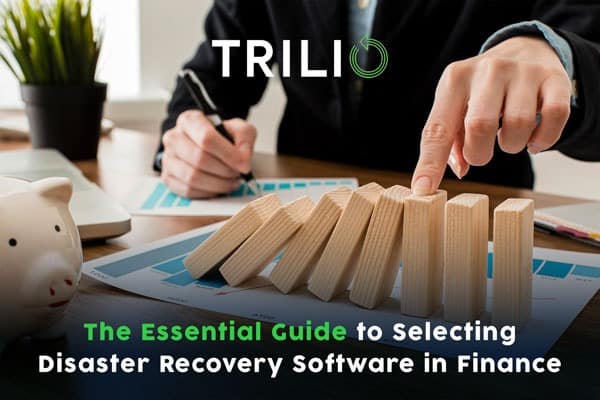Why Financial Services Need a Highly Reliable Disaster Recovery Strategy
For financial services, having top-notch disaster recovery software is absolutely essential. Here’s the deal: when financial systems encounter a problem, whether through a data breach or a technical failure, the repercussions are far-reaching. It’s more than a tech problem, it’s about protecting people’s money and personal information. Financial institutions operate in a league of their own, requiring disaster recovery plans tailored specifically to their needs.
The stakes in the finance sector are exceptionally high. Even brief downtime can spiral into significant financial turmoil. Picture this: an online banking system crashes or, in a worse scenario, suffers a data breach. The fallout isn’t just measured in immediate financial terms but also in the erosion of customer confidence and the tarnishing of a company’s reputation.
Key Steps for Resilient IT Systems in Finance
Building a robust IT framework in financial services requires a multi-layered approach, where each layer reinforces the others, ensuring a resilient system. Below, we’ve outlined the key steps and aligned them with technologies such as OpenStack, Kubernetes, and OpenShift. This showcases how effective technology can work in harmony with well-defined practices in the financial sector.
Understanding Industry-Specific Risks: The financial industry is subject to its unique set of threats, such as insider fraud, payment fraud, and the increasing use of cryptocurrencies for illegal money transfers. It’s crucial to understand these risks and take steps to protect a company from massive losses and reputational damage. Starting with OpenStack for a secure cloud infrastructure is a great step. In this scenario, Trilio can act as an additional safety layer, ensuring that your disaster recovery plan is not only robust but also adheres to top-tier data protection practices.
OpenStack, with its cloud capabilities, provides a flexible and secure environment for storing and managing large volumes of information.
Disaster Planning That Works: A static disaster recovery plan is vulnerable. Regular drills and updates are crucial. Kubernetes can be a game-changer in this context. Its container orchestration capabilities allow for easy testing and deployment of updates across distributed systems, ensuring that your disaster recovery plan is not only current but also comprehensive and agile in the face of new threats and technological shifts. When integrated with Kubernetes, Trilio enhances this process, providing more efficient backup and recovery strategies, ensuring that your disaster recovery solutions are resilient.
Kubernetes helps manage containerized applications across multiple servers, offering a scalable and efficient way to handle applications and data.
Prepare for the Worst: Consider a scenario where a major financial institution falls victim to a large-scale cybersecurity breach that exposes sensitive customer data. When such a disaster strikes, the readiness of your staff can make or break the recovery process. Regular, detailed training sessions ensure that every team member is aware of their role and responsibilities within the disaster recovery plan. This training should include practical scenarios that incorporate the use of company technologies, like OpenShift, which simplifies complex processes and ensures that all employees, regardless of their technical expertise, can respond effectively during a crisis. Trilio can be part of this training, demonstrating how advanced backup and recovery solutions can be effectively managed in critical situations, reducing human error and response times.
OpenShift streamlines the development and deployment of applications, crucial for dynamic financial services.
Selecting the Right Disaster Recovery Software
Financial services store heaps of sensitive data, making them a goldmine for hackers. A breach can lead to identity theft and financial fraud, costing millions. Plus, the financial sector is heavily regulated. Non-compliance due to inadequate disaster recovery measures can lead to hefty fines and legal issues. The recent spike in ransomware attacks on financial institutions adds another layer of urgency to have a comprehensive disaster recovery strategy for financial services.
Learn how Trilio helps a major bank with almost 20 million customers
So, what should a company operating in the financial sector look for in effective disaster recovery software?
Automated & Agile Recovery: Opt for a software solution that leverages advanced automation and orchestration capabilities, ensuring rapid adaptation to diverse disaster scenarios, including cross-region and cross-account recovery.
Seek features like API-driven automation and policy-based orchestration that can dynamically adjust to changing IT environments. Look for capabilities like geographically dispersed data replication and multi-cloud management to enhance resilience.
Compliance and Security: The software must strictly adhere to industry-specific regulations such as GDPR, SOX, or PCI-DSS and offer security measures like end-to-end encryption and multi-factor authentication.
Verify that the disaster recovery solution incorporates comprehensive security protocols and is regularly updated to comply with the latest regulatory standards.
Quick Recovery Times: Prioritize a solution that offers minimal Recovery Time Objectives (RTO), utilizing technologies like incremental backups and real-time replication.
Assess solutions that provide rapid data restoration and failover mechanisms to ensure business continuity. For rapid data recovery solutions, explore Trilio’s Continuous Restore service.
Service Availability: High availability is non-negotiable in the financial sector. The software should support a fault-tolerant architecture and seamless failover capabilities.
Look for solutions that employ clustering and load balancing to maintain uninterrupted service availability. Understanding your MTD (Maximum Allowable Downtime) is crucial in determining the resilience of your IT infrastructure. Choose software that supports detailed risk assessments and business impact analysis to accurately determine your MTD.
Perform secure central application centric backup container, vms, helm & Operator
Used Pre-Stage snapshots to instantly test, transform and restore during recovery
Scale with fully automated policy-driven backup and recovery worklow
What's Next?
In finance, choosing the right disaster recovery software is a decision you can’t afford to get wrong. It’s about ensuring uninterrupted operations, safeguarding customer data, and staying ahead of regulatory curves. Trilio, with its advanced features and compliance-oriented design, stands as a smart choice for financial institutions navigating the complex world of disaster recovery.
Learn more about Trilio’s tailored approach for financial services at Trilio for Financial Services Industry or get a personalized demo for your company.

